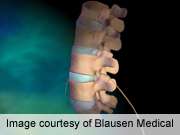A variety of pre-, intra-, and postoperative factors contribute to increased length of stay for patients who undergo level 1 minimally invasive transforaminal interbody fusions spine surgery, according to a study published online May 8 in Spine.
(HealthDay) -- A variety of pre-, intra-, and postoperative factors contribute to increased length of stay (LOS) for patients who undergo level 1 minimally invasive (MIS) transforaminal interbody fusions (TLIF) spine surgery, according to a study published online May 8 in Spine.
Krzysztof Siemionow, M.D., of the University of Illinois in Chicago, and colleagues conducted a retrospective study of 104 patients undergoing a MIS TLIF spine surgery procedure to identify pre-, intra-, and immediate postoperative parameters that predict discharge 24 hours or more after surgery.
The researchers found that, of the patients with an LOS of more than 24 hours, 75 percent had significantly higher estimated blood loss, higher total fluids, longer surgical time, lower end of case temperature, and lower hemoglobin during hospitalization; they also had lower preoperative narcotic use and received more crystalloids. In a multiple regression analysis, significant predictors of increased LOS included postoperative creatinine, visual analogue scale score, oxycontin use, fluid input at the end of surgery, fluid balance, intraoperative colloids, crystalloid:colloid ratio, mean percentage of fraction of inspired oxygen, and preoperative hemoglobin.
"Length of stay is an important factor in determining health care costs in patients undergoing spine surgery," the authors write. "Proper fluid management, preoperative narcotic use, and careful management of creatinine may lead to a shorter length of hospital stay in patients undergoing spine surgery."
One or more of the authors received a benefit from a commercial entity related to the subject matter of this study.
More information:
Abstract
Full Text (subscription or payment may be required)
Copyright © 2012 HealthDay. All rights reserved.



















